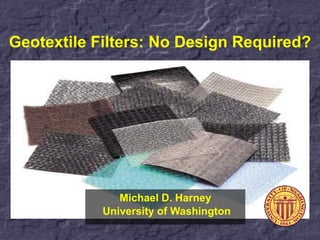
Geotextile Filter Design
- 1. Geotextile Filters: No Design Required? Michael D. Harney University of Washington
- 2. Why Use a Geotextile? Geotextile filters offer • Comparable performance • Improved economy • Consistent properties • Ease of placement
- 3. Applications • Filters around trench and edge drains Trench Drain Installation, 1
- 4. Applications • Filters around trench and edge drains Trench Drain Installation, 2
- 5. Applications • Filters around trench and edge drains Trench Drain Installation, 3
- 6. Applications • Filters around trench and edge drains A Geocomposite Trench Drain
- 7. Applications • Filters around trench and edge drains Edge Drain Installation
- 8. Applications • Drains for retaining walls and abutments Panel Drain Installation
- 9. Applications • Drains for retaining walls and abutments Panel Drain Schematic
- 10. Applications • Wraps for slotted or jointed drain and well pipes
- 11. Applications • Interceptor, toe drains and surface drains
- 12. Applications • Chimney and toe drains for earth dams and levees
- 13. Mechanism A geotextile serves as a catalyst to promote the upstream soil to generate its own internal filter.
- 14. Design Req’d? Must perform the same functions as a graded granular filter: • Retain the soil (retention) • Allow water to pass (permeability) • Function for life of structure (clogging)
- 15. Design Most Widely Used Criteria: FHWA GTx Filter Design Criteria (Christopher and Holtz, 1985)
- 16. Level of Design Req’d 1. Assess project’s nature: • A critical or less critical project? 2. Assess severity of hydraulic conditions: • Severe or less severe?
- 17. Criticality Critical Nature of the Project Item Critical Less Critical Risk of loss of HIGH NONE life / damage Repair cost vs Very Great Equal to or installation cost Less Evidence of None Apparent clogging
- 18. Severity Severity of the Conditions Item Severe Less Severe Soil to be Gap-Graded; Well-Graded; Drained pipable; Uniform dispersive Hydraulic HIGH Low Gradient Flow Conditions Dynamic; Steady State Cyclic or Pulsating
- 19. Filter Design Retention Criteria AOS or O95 B D85 Sands (< 50% passing No. 200 sieve): Cu B <2 1 2 Cu4 0.5Cu 4< Cu<8 8/Cu 8 1
- 20. Filter Design Retention Criteria (cont’d.) AOS or O95 B D85 Silts or Clays (> 50% passing No. 200 sieve): Geotextile Type B woven 1 nonwoven 1.8 For both AOS 3mm
- 21. Filter Design Retention Criteria (cont’d.) AOS or O95 B D85 For dynamic, pulsating or cyclic flow: Use B = 0.5
- 22. Filter Design Permeability / Permittivity Criteria Permeability: Project Nature Criterion Less Critical kgeotextile ksoil Critical kgeotextile 10ksoil
- 23. Filter Design Permeability / Permittivity Criteria (cont’d.) Permittivity: kgeotextile / tgeotextile % passing No. 200 Criterion <15% 0.5 s-1 15% to 50% 0.2 s-1 >50% 0.1 s-1
- 24. Filter Design Clogging Resistance For less critical / less severe conditions: O95 (geotextile) 3 D15 (soil) AND: • For nonwovens: ngeotextile 50% • For wovens: Percent Open Area 4% For critical / severe conditions: • Perform a FILTRATION TEST with on-site soils and candidate geotextile.
- 25. Conventional Clogging Tests • Existing tests: – Gradient ratio (GR) test (ASTM D 5101) – Hydraulic conductivity ratio (HCR) test (ASTM D 5567) • GR and HCR have disadvantages
- 26. The Flexible Wall Gradient Ratio Test (FWGR) • A gradient ratio test using a flex wall permeameter. • Overcomes GR and HCR disadvantages • Biggest advantage: TIME REQUIRED
- 27. Filter Design Survivability and Endurance Survivability • Must be sure that the geotextile can survive the construction process. Endurance • Biological / chemical clogging • Ultraviolet Degradation
- 28. Other Selection Considerations 1. For graded gravels and coarse sands: very open monofilament wovens high flow rates permitted; low risk of blinding 2. Sands and Gravels, <20% Fines: Open monofilament wovens, needlepunched nonwovens reduce the risk of blinding 3. 20% to 60% fines: Filtration tests are recommended
- 29. Other Selection Considerations (cont’d) 4. >60% Fines: Heavy weight, needlepunched NWs and heat-bonded NWs work best—fines will not pass. 5. Gap-Graded, Cohesionless: Consider a uniform sand filter above a very open geotextile 6. Silt w/ sand seams: Consider a heavy (thick) NP NW so water may flow laterally through GTx, if it becomes locally clogged.
- 30. Considerations for Geocomposites 1. Compaction directly against the filter should be avoided. Consider using clean granular backfill against the drain. 2. Careful overlapping required at joints to prevent infiltration. 3. Geotextile should extend beyond the ends of the drain
- 31. Helpful References Design Procedure: • Geosynthetic Engineering; Holtz, et al. • Designing w/ Geosynthetics; Koerner Available Products and Specs • GFR Specifier’s Guide, 2002 Ed.
- 32. Solid Advice ―All geotextiles will work in some applications, but no one geotextile will work in all applications‖ --The Late Allan Haliburton Geosynthetics Pioneer